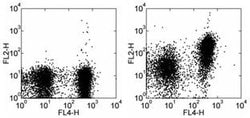Learn More
Invitrogen™ CD150 Monoclonal Antibody (9D1), Biotin, eBioscience™
Rat Monoclonal Antibody
Supplier: Invitrogen™ 13150182

Description
Description: The 9D1 monoclonal antibody reacts with mouse CD150, an ~70 kDa transmembrane glycoprotein also known as Signaling Lymphocyte Activation Molecule (SLAM). CD150 is expressed by T (especially TH1) and B cells and its expression is rapidly upregulated on these cells upon activation. Immature thymocytes and dendritic cells also express this antigen. Signaling through SLAM in T cells induces proliferation and augmentation of the interferon-gamma response. Furthermore, SLAM is thought to play a role in adhesion between the T cell and antigen-presenting cell. 9D1 is reported to be an activating antibody. Mouse hematopoietic stem cells (HSC) can be identified using SLAM family markers, such as CD150+CD244-CD48-. For this application we recommend the use of antibody clone mShad150 (Product # 12-1502). Applications Reported: This 9D1 antibody has been reported for use in flow cytometric analysis. Applications Tested: This 9D1 antibody has been tested by flow cytometric analysis of mouse thymic and splenic cells. This can be used at less than or equal to 0.5 μg per test. A test is defined as the amount (μg) of antibody that will stain a cell sample in a final volume of 100 μL. Cell number should be determined empirically but can range from 10^5 to 10^8 cells/test. It is recommended that the antibody be carefully titrated for optimal performance in the assay of interest. Filtration: 0.2 μm post-manufacturing filtered.
CD150, also known as SLAM (Signaling Lymphocyte Activation Molecule), is a member of the immunoglobulin gene superfamily and plays a crucial role in T cell stimulation and immune cell interactions. It is constitutively expressed on peripheral blood memory T cells, T cell clones, immature thymocytes, and a proportion of B cells. CD150 expression is rapidly upregulated upon activation, particularly on naive T cells, Th1 cells, and activated B cells, which express the membrane-bound, soluble, and cytoplasmic isoforms of SLAM. In T cells, signaling through SLAM induces proliferation and enhances the interferon-gamma response. SLAM is also involved in adhesion between T cells and antigen-presenting cells, facilitating immune cell interactions. Homophilic SLAM-SLAM binding during B to B and B to T cell interactions is suggested to enhance the expansion and differentiation of activated B cells. CD150 serves as a receptor for the measles virus and acts as a co-activator on T and B cells. It interacts with SH2D1A and PTPN11 via its cytoplasmic domain, playing a role in signal transduction. Mutations in the CD150 gene may be associated with X-linked lymphoproliferative disease (XLP), highlighting its importance in immune regulation and disease pathology.
Specifications
| CD150 | |
| Monoclonal | |
| 0.5 mg/mL | |
| PBS with 0.09% sodium azide; pH 7.2 | |
| Q9QUM4 | |
| Slamf1 | |
| Affinity chromatography | |
| RUO | |
| 27218 | |
| 4°C, store in dark, DO NOT FREEZE! | |
| Liquid |
| Flow Cytometry | |
| 9D1 | |
| Biotin | |
| Slamf1 | |
| 4933415F16; AA177906; CD150; CD150 antigen; CDw150; ESTM51; IPO-3; RGD1560634; signaling lymphocyte activation molecule; signaling lymphocytic activation molecule; signaling lymphocytic activation molecule family member 1; Slam; SLAM family member 1; Slamf1 | |
| Rat | |
| 100 μg | |
| Primary | |
| Mouse | |
| Antibody | |
| IgG1 κ |
The Fisher Scientific Encompass Program offers items which are not part of our distribution portfolio. These products typically do not have pictures or detailed descriptions. However, we are committed to improving your shopping experience. Please use the form below to provide feedback related to the content on this product.
